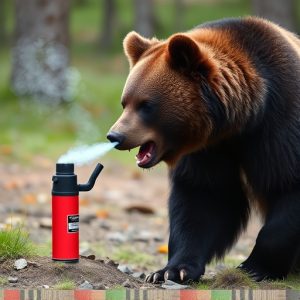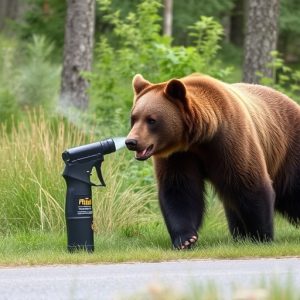Bear Spray Ingredients & National Park Regulations: Staying Safe Outdoors
In National Parks, understanding Bear Spray Laws is crucial for safety during potential bear encount…….
In National Parks, understanding Bear Spray Laws is crucial for safety during potential bear encounters. Bear spray, containing capsicin oleoresin, disrupts bears' sensory systems, offering a brief window of safety. Park rangers emphasize proper usage, knowledge of local guidelines, and respect for regulations to ensure both human safety and habitat preservation. Always research and comply with Bear Spray Laws National Parks before venturing into the wilderness.
“Unraveling the power behind bear spray, this article delves into its active ingredients, specifically Capsaicin Oleoresin, and its pivotal role in deterring bears. With a focus on safety, we explore the legal considerations regarding bear spray in national parks, guiding you through essential guidelines.
From understanding the chemical composition to navigating Bear Spray Laws in National Parks, this comprehensive read ensures you’re prepared for outdoor adventures while coexisting harmoniously with these majestic creatures.”
- Understanding Bear Spray Ingredients: Capsaicin Oleoresin and Its Role
- Bear Spray Laws in National Parks: What You Need to Know
- Safety Measures When Using Bear Spray in Outdoor Settings
Understanding Bear Spray Ingredients: Capsaicin Oleoresin and Its Role
Bear spray, a crucial tool for outdoor enthusiasts and wilderness travelers, is designed to deter aggressive bears when used correctly. At the heart of this potent defense mechanism lies capsicin oleoresin, a key active ingredient responsible for its effectiveness. This natural compound, derived from chili peppers, has gained recognition not only in bear spray but also in various pain management products due to its powerful properties.
In the context of Bear Spray Laws in National Parks, understanding capsicin oleoresin becomes imperative. Its role extends beyond causing a burning sensation; it disrupts the bear’s sensory perception and communication systems. This disruption can lead to the bear losing interest or retreating, providing valuable time for escape or safety. The presence of capsicin oleoresin in bear spray is a game-changer, enabling individuals to navigate through potential bear encounters with increased confidence and safety, while also promoting responsible wildlife interaction within national parks.
Bear Spray Laws in National Parks: What You Need to Know
In many national parks across the globe, carrying bear spray is mandatory for visitors due to the potential risk of encountering bears. These laws vary from park to park, but they are put in place to ensure visitor safety and minimize human-wildlife conflict. Understanding the Bear Spray Laws in National Parks is crucial before planning a trip to these natural wonders. The primary consideration is often the type and quantity of bear spray allowed, with regulations dictating specific concentrations of active ingredients like capsaicin oleoresin.
Park rangers emphasize that proper usage and knowledge of local guidelines are just as important as having bear spray. Visitors should familiarize themselves with the recommended distances for spraying and practice handling the can in advance. Non-compliance with Bear Spray Laws can result in fines or even denial of entry, so it’s essential to stay informed and respect the regulations aimed at preserving both human safety and the natural habitat of these protected areas.
Safety Measures When Using Bear Spray in Outdoor Settings
Using bear spray is a common safety measure in outdoor settings, especially in areas known for bear populations like national parks. However, it’s crucial to understand that bear spray laws vary across different regions and national parks. Before heading into the wilderness, research and familiarize yourself with the specific regulations of your intended destination. Bear spray should only be used as a last resort when an attack is imminent; it’s not meant for general deterrence.
Always inspect the spray before use to ensure the canister is intact and the nozzle is clear. Practice proper usage techniques by familiarizing yourself with the spray’s range, wind conditions, and how to aim accurately. Store bear spray out of reach of children and pets, and never leave it unattended. Regularly check expiration dates, as the effectiveness of the spray can diminish over time. Remember, responsible use of bear spray contributes to the safety not only of individuals but also to the preservation of these natural habitats for future generations.
In conclusion, understanding the active ingredients in bear spray, particularly capsaicin oleoresin, is crucial for anyone planning outdoor activities in national parks where bear encounters are possible. Knowing the legal requirements regarding bear spray possession and use in these areas is equally important to ensure compliance with local regulations. Always prioritize safety when using bear spray by following recommended guidelines to effectively deter and minimize potential risks from wild bears.


